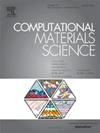用第一性原理和玻尔兹曼输运研究尖晶石MgGa2O4的高温热电性能
IF 3.3
3区 材料科学
Q2 MATERIALS SCIENCE, MULTIDISCIPLINARY
引用次数: 0
摘要
本文研究了以Fd-3 m (No.227)立方结构结晶的宽禁带材料尖晶石MgGa2O4的结构、电子和热电性能。在具有GGA + mBJ势的WIEN2k框架中,采用FP-LAPW方法的第一原理计算显示,Γ-point处的直接带隙为4.9 eV。温度和化学势(μ)对塞贝克系数(S)的显著影响使得BoltzTraP能够深入分析输运性质。在μ =±0.05 eV附近,S在600 K时具有特殊的热电活性,超过±20,000 μ v /K。然而,随着温度的升高,双极传导形成,这大大降低了塞贝克系数。在整个温度范围内,掺杂响应保持一致的不对称性,导热系数(κ/τ)和电导率(σ/τ)的趋势有利于s - p型输运。通过增强载流子激发、降低晶格热导率和优化熵滤波,计算得到的ZT值在1200 K时超过1.2。在μ = 0附近的宽而对称的ZT峰突出了材料的平衡的n型和p型性能。这些结果突出了MgGa2O4作为一种高温热电材料的潜力,可以用于极端环境下的能量转换和废热回收。这进一步证明了掺杂和温度优化对于最大限度地提高宽禁带氧化物的热电效率的重要性。该材料适合在600 K以下的温度下进行储能。本文章由计算机程序翻译,如有差异,请以英文原文为准。

High-temperature thermoelectric performance of spinel MgGa2O4 through a first-principles and Boltzmann transport study
The structural, electronic, and thermoelectric properties of spinel MgGa2O4, a wide-bandgap material crystallizing in the Fd-3 m (No.227) cubic structure, are investigated in this work. In the WIEN2k framework with the GGA + mBJ potential, first-principles calculations employing the FP-LAPW approach show a direct band gap of 4.9 eV at the Γ-point. Significant impacts of temperature and chemical potential (μ) on the Seebeck coefficient (S) result in a thorough analysis of the transport properties using BoltzTraP. Near μ = ±0.05 eV, S had exceptional thermoelectric activity at 600 K, surpassing ± 20,000 μV/K. However, bipolar conduction forms as the temperature rises, which drastically lowers the Seebeck coefficient. A consistent asymmetry in the doping response remains throughout the temperature range, and trends in thermal conductivity (κ/τ) and electrical conductivity (σ/τ) favor S. P-type transport. Through enhanced carrier excitation, decreased lattice thermal conductivity, and optimal entropy filtering, the calculated ZT values surpass 1.2 at 1200 K. The balanced n-type and p-type performance of the material is highlighted by broad, symmetric ZT peaks around μ = 0. These results highlight the potential of MgGa2O4 as a high-temperature thermoelectric material that can be utilized for energy conversion and waste heat recovery in extreme environments. It further demonstrates the importance of doping and temperature optimization in maximizing thermoelectric efficiency in wide-bandgap oxides. The material is suitable for energy storage at temperatures below 600 K.
求助全文
通过发布文献求助,成功后即可免费获取论文全文。
去求助
来源期刊

Computational Materials Science
工程技术-材料科学:综合
CiteScore
6.50
自引率
6.10%
发文量
665
审稿时长
26 days
期刊介绍:
The goal of Computational Materials Science is to report on results that provide new or unique insights into, or significantly expand our understanding of, the properties of materials or phenomena associated with their design, synthesis, processing, characterization, and utilization. To be relevant to the journal, the results should be applied or applicable to specific material systems that are discussed within the submission.
 求助内容:
求助内容: 应助结果提醒方式:
应助结果提醒方式:


